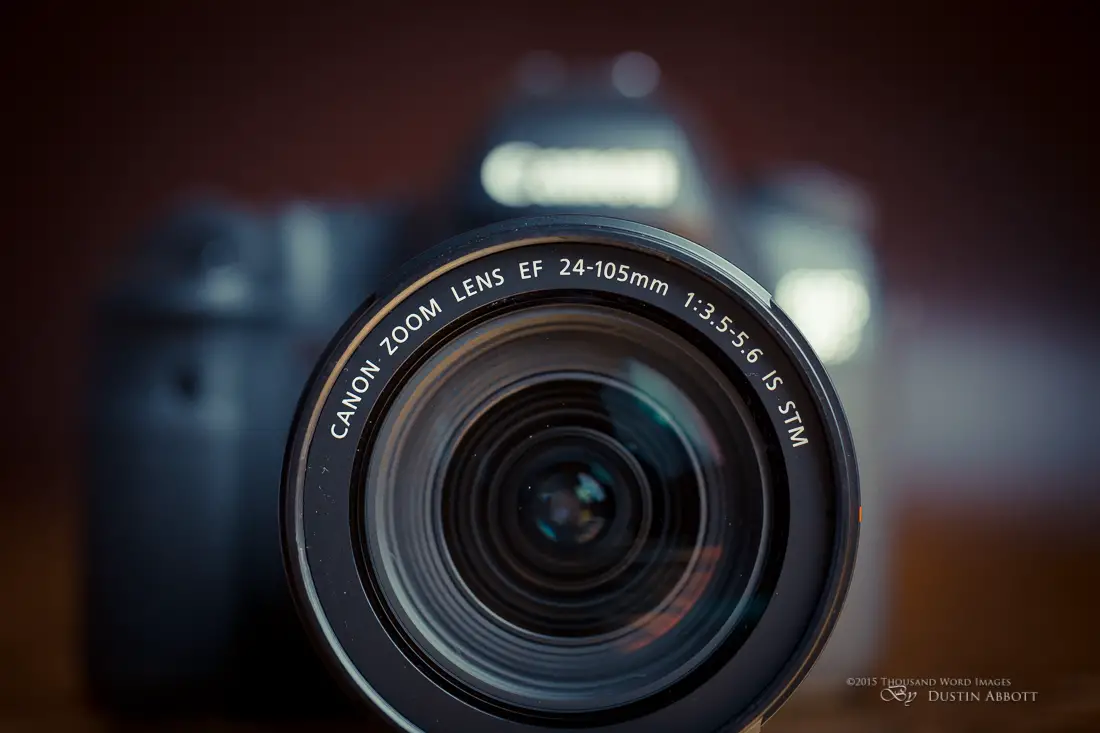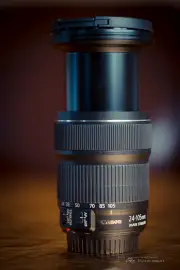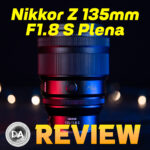Canon EF 24-105mm f/3.5-5.6 IS STM Review
Dustin Abbott
January 7th, 2015
The Elephant in the Room
Before we can get to the “what” of this lens, we first have to pause to answer the “why” of this lens, as the first question for many when they become aware of this lens is, “Doesn’t Canon already have one of those?“
Yes, in a way.
The Canon EF 24-105mm f/4L IS is an excellent lens that few people are complaining about. It isn’t the “sexiest” or most exotic option out there, but it is extremely competent with a great build quality, good optics, and a solid IS system. It is a member of Canon’s “L” series, and though it is more accessible and familiar because of its inclusion in camera kits over the years, I believe it is a deserving member of the family. I’ve owned three copies (although one came in a kit that I bought only to resell – like many others, and that will become very relevant in a moment), and I moved the last one only because I liked the Tamron 24-70 VC so much that I found I wasn’t using the 24-105L anymore. Still, I had little to complain about regarding the 24-105L other than a little more barrel distortion than what I would have liked.
Muddying the waters is the fact that Canon released a 24-70 f/4L IS about a year ago. In a confusing move, it was initially priced considerably higher than the 24-105L despite a more limited range and optics that were only marginally better. It did offer one unique feature, however, in the form of a 1:2 macro mode. Further muddying of the waters came via Sigma, who released their own version of the 24-105mm f/4 OS. These lenses each seemed to be answering a question that no one was asking, however. As I said, few people were complaining about the existing option.
It should be noted that the Canon 24-70 f/4L has seen its price dramatically cut (often retailing now for about half of its original MSRP, while Sigma has just recently announced that the assembly lines producing their 24-105 OS have been retasked to produce other product. Whether this is temporary or permanent is unknown, but obviously sales have not met expectations.
So why is Canon releasing yet another lens in this focal range? The answer to that question, the Canon EF 24-105mm f/3.5-5.6 IS STM, probably has a chance of succeeding in a way that the previous two did not for one primary reason. While the former two lenses tried to position themselves as either direct competitors or superior to the 24-105L , the 24-105 STM takes this very popular focal length and repackages it for the masses in a lighter, cheaper, way. The 24-70 f/4L IS (while an excellent lens) failed at its initial price point in large part because it had an abbreviated focal length with only marginally better optics. The Sigma seems to have failed because it offered no clear advantages (sort of a give and take) over the 24-105L in a heavier package.
So once you get over the “why?” and just take the “what” of this lens at face value, you find a very competent lens. The trend of many lenses that Canon has offered in the past few years have been lenses that didn’t necessarily wow people on paper (or thrill them with their announcement) but have proven to be extremely competent lenses that have won people over on their merits. It is, in many ways, the mirror opposite of Sigma. Sigma has released a series of exciting lenses like the 35mm f/1.4 ART that people desperately want to love but are sometimes disappointed by the execution of those lenses (AF consistency, anyone?). By contrast, the Canon 35 f/2IS was far less exciting to the photography community but has become one of my favorite lenses because it is so good (its focus accuracy is astoundingly good!)
STM?
Canon has been refreshing a number of its popular EF-S models (crop sensor) with STM versions. STM stands for “Stepping Motor”, and represents a new, different approach to autofocus that is a departure from Canon’s previous “two-tier” approach of putting USM (Ultrasonic Motor) AF systems in their more premium lenses and micro-motors in their more basic models. STM is a definite improvement over the micro-motor system, which tended towards being louder and slower. They also did not allow for full time manual override, which STM motors do. I still prefer the better USM motors (they aren’t all created equally) because of their still better speed and also the quality of the manual override focus. STM does offer one advantage, however, and that is the “stepping” of the motor provides smoother autofocus for cameras which offer a servo AF focusing mode during video recording. The principle downside of STM, however, is the rather annoying disconnect when you do need to manually focus, as the focus ring isn’t physically connected to moving the elements but is rather a “focus by wire” where the focusing motor still moves the elements. There tends to be a bit of lag between your movements and the actual moving of the elements into focus. You can mentally adjust after some familiarity, but for someone like me who uses a large variety of lenses (most of which aren’t STM), this isn’t my favorite approach.
The STM versions of popular focal lengths like 18-55, 55-250, 18-135, etc…have universally proven to be significant improvement over their predecessors. Better optics, better designs, and the STM motor have been an improvement over the micromotors these lenses previously had. The 24-105 STM is somewhat different, as there wasn’t really a similar lens that this is “improving” upon. It is also unique because relatively few EF lenses has received a STM motor (the 40mm f/2.8 Pancake is the only other to date). The 40mm STM is a very unique lens in the Canon lineup because of its extremely small form factor, so the STM was logical because it is a more compact AF system and obviously can be produced more cheaply than USM.
The 24-105mm focal length is optimized for the full frame sensor, as the Canon crop sensor of 1.6x creates a focal length equivalent of 38.4-168mm. The long end is appealing, but 38.4mm is not particularly wide. The EF-S 18-135mm STM is far more effective focal range for crop sensors. The technology that takes advantage of the stepping motor for video is not currently in place on any of Canon’s full frame offerings, so one wonders if this signifies Canon’s plan to implement this technology in future full frame cameras. I get the sense that this is a lens planned, produced, and released more as part of Canon’s future plans than to address a specific need in the present. The inevitable price drop and perhaps inclusion of this lens in kits will further broaden its appeal.
Specs and Details
In execution, this is a very nice lens. It is not particularly shorter than the 24-105L (4.09″/104mm vs 4.2″/106.7mm) and shares the same 77mm front element, but it is considerably lighter (18.52oz/525g vs. 1.47lb/670g). This is actually a very light lens that is unlikely to tax anyone’s strength or ability to use it. It is light enough that it pairs reasonably well even with my EOS M body. The build and appearance is not dissimilar to other recent mid-grade offerings from Canon. It utilizes the same engineered plastics but feels less dense than some of the more premium lenses. It does have a metal bayonet mount. Inside there are 17 elements in 13 groups, and the aperture iris has 7 rounded blades that will remain fairly circular when stopped down. There is a nice wide ring for zoom (closest to the camera) with a more narrow ring (yet still nicely sized) close to the end of the barrel for focus. Like other STM lenses, there is no distance window, which is yet another strike against manual focusing.
A zoom lock is included to prevent lens/zoom “creep”, but I doubt it will be needed all that often as the front element of the lens is actually very light and the lens exhibited no tendencies towards creeping in my experience. That being said, I find that my preferred way of carrying lenses in the field (via a Black Rapid strap) means that sometimes as I stride along my leg will actually brush the zoom ring on certain lenses and cause the barrel to extend even if the lens doesn’t exhibit zoom creep, so having the lock is certainly better than not having it.
A feature to note is that this lens focuses down to 40cm, which is actually 5cm less than the 24-105L. This means that the lens will produce a maximum magnification of .30x, which is better than the .23x the 24-105L provides and is extremely useful. Here are few samples taken at close range:
One cosmetic detail I noted is that the switches along the left side of the barrel are rotated up a bit higher than Canon’s standard position. I actually checked the lens a few times to see if it was completely mounted, as it seemed that the lens wasn’t fully “twisted” into place because of the unfamiliar placement of the switches. This new position is a little more visible than the previous placement from the top of the camera, and that probably explains the change. The two switches, as expected, are the switch for AF/MF (although full time manual override is available) along with an ON/OFF switch for the Image Stabilizer.
This is actually a very nice implementation of Canon’s IS. It is, in my experience, completely inaudible and completely mannerly. No “jerking” of the image as the IS settles in, no noise indicating when it starts or stops. It is very effective, however, and even out in the cold I was able to successfully handhold images at 105mm at times of 1/10th second and even a few at 1/6th second. In my experience the execution of IS in this lens is amongst the best to date from Canon. This is one area where the STM version trumps the L series lens. The image bellow was taken in cold conditions, wearing gloves, and standing in deep snow, and I still easily managed a 1/10th exposure time at 105mm.
One significant difference with this new STM lens is that it is a variable aperture zoom, unlike the constant f/4 aperture of the 24-105L across its zoom range. The STM lens is technically faster on the wide end (f/3.5 vs. f/4), but that advantage literally only lasts for 4-5mm, for the lens is at f/4 by 30mm. F/4 lasts only to about 40mm, where the aperture closes to f/4.5. F/5 comes around 50mm and f/5.6 comes around 68mm where it remains over the remainder of the focal length.
- 24-29mm = f/3.5
- 30-40mm = f/4
- 40-50mm = f/4.5
- 50-68mm = f/5
- 69-105mm = f/5.6
This is not a fast lens in terms of aperture, but at the same time the improved ISO performance of Canon’s current generation of cameras makes this less of an issue than times past.
Optically Sound
The focal range is, of course, excellent. This two shot series shows off both the nice color rendition from the lens (minimal processing) and the dramatically different perspectives between 24 and 105mm.
It is certainly no slouch in the optical department. I encourage you to take a look here if you would like to see how the lens performs in chart testing. The lens is certainly not far off the standard set by the L series lens. My sense of a good performance is skewed a bit by testing a number of optically incredible lenses recently (Zeiss Otus 85, Distagon 15mm, Makro-Planar 50mm f/2, Sigma 50mm f/1.4 ART, and even the Rokinon 12mm f/2), but none of these optically superior primes are true comparisons. I don’t think that many people will be disappointed with the image quality this lens provides, and it seems to do a good job with chromatic aberrations other than some fringing in the corners that gets slightly more pronounced as you move through the focal range. Flare is nicely handled and I didn’t experience any issue with ghosting. Stopping down produced a nice thirteen point sunburst. This two shot series shows off both the very nice sunburst and the lens’ extreme resistance to flare and ghosting.
This is not a “bokeh lens”, per se, with its modest telephoto length and relatively narrow maximum aperture, but one can produce a nicely diffused background by shooting at the longer end of the focal length with your subject relatively close to the camera.
I felt like color rendition with the lens was quite good, and it did not seem far off the very nice Zeiss Makro-Planar lens that I was reviewing at the same time.
My conclusion after using the lens for a while is that it has very few optical shortcomings. It is also somewhat bland in that is competent without being particularly exceptional in any way. For most people that should be just about perfect, as the quirks of some lenses that a few professionals can take advantage of are also shortcomings that will frustrate others. This is a very “safe” choice.
Quibbles
I can’t leave this review without mentioned one minor quibble that I found fairly irksome. The packaging of this lens is the worst I have seen…ever. It literally is the box with the lens surrounded with bubble wrap inside. One would think they were opening an Ebay purchase rather than a new lens from Canon. First impressions matter, and I think that Canon could do better in presentation than this very half-hearted effort. Fortunately the lens itself seems like far more thought was put into it. It is very competent.
Just to bang the drum one more time: Canon, it is time to start including lens hoods. They cost you next to nothing to produce, but make a big difference for those who use them.
The lens does have some pronounced barrel distortion on the wide end and a bit of pincushion distortion on the long end, but fortunately the most recent release of Adobe Lightroom/Camera RAW includes a profile that does a sound job of correcting that distortion. This series shows the before/after.
Conclusions
But this brings us full circle to the original issue. The biggest challenge to this lens is not external; it is the existence of the 24-105mm f/4L IS. On paper it doesn’t seem like they are competitors. The official list price for the 24-105L is $1149 at B&H; the STM lists at $599. But few people have ever paid full price for a 24-105L. There are myriad copies available on the used market, and when purchased in a kit with a camera body the average difference between the body only and kit with the lens is about…wait for it…$600. I would expect the median price for the 24-105L is probably closer to $800, which is close enough that there will be a number of people that are cross-shopping the two lenses.
Still, I am going to credit Canon with being more far-sighted than what it might seem in December of 2014 when I am completing this review. I don’t think this lens is designed for 2014’s prices or 2014’s cameras. STM technology cannot be leveraged by the current full frame camera bodies, but clearly this is going to change. I cannot imagine Canon’s next full frame bodies not using Dual Pixel AF technology, as this is one of Canon’s most cutting edge sensor selling features (and Canon is in dire need of whatever sensor advantages it can find right now!) Furthermore, I wouldn’t be surprised to see this lens used in cheaper kit configurations as the older EF 28-135mm gets phased out. Lenses rarely remain at the price level they are introduced at, and the inevitable gradual price reduction of the lens will help to create further space between it and the real street price of the 24-105L.
In conclusion, the good news is that people who overlook the “why” of the Canon EF 24-105mm f/3.5-5.6 IS STM and get into the “what” of its reality are going to find a nicely competent, well executed lens with a fair bit of versatility. It’s not an exciting lens, but it has few flaws, too. The 24-105mm range is an excellent one, allowing for both landscape/wide angle shots (24mm is a great focal length!) along with a decent amount of telephoto length on the long end. The 85-105mm range is a prime range for portraiture, and in many situations a portrait photographer would stop down to at f/5.6 anyway for head and shoulders type shots because the depth of field becomes so shallow that only certain features are in focus. I’m rarely a fan of variable aperture lenses, but the reality is that almost all consumer grade zooms are variable aperture. It is this concession that allows them to be lighter and cheaper. That aside, this lens provides solid optics, great image stabilization, and fast, quiet focus. It is a lens that I believe will make more and more sense as Canon introduces it as a kit bundled with cameras at a lower price point and as Canon’s next generation of full frame camera bodies add the technology that can fully utilize this lens. But one still has to answer one question: what about Canon’s other 24-105mm lens?
Pros:
- Excellent focal range
- Good optical performance across the focal range
- Excellent maximum magnification figure of .30x
- Excellent Image Stabilization
- STM focus is quiet, quick, and accurate
- Very good color rendition
- Excellent flare resistance and no apparent ghosting
Cons:
- Variable aperture
- Combination of STM motor and no focus window makes manual focus a chore
- Some apparent CA, particularly toward the periphery of the frame
- No lens hood and poor packaging
- Not the 24-105mm f/4L IS
Notes: This lens was a retail copy provided for review purposes by B&H Photo. All photos included in the review were taken by myself and have had minimal processing. They are representative of the lens’ performance. A Canon 6D body was used as the review instrument.
Check out the lens gallery here: (Includes some full size samples for download)
You may also like:
Tamron 28-300mm f/3.5-6.3 VC Review
Tamron 24-70mm f/2.8 Di VC USD Review
Canon EF 35mm f/2 IS USM Review
Gear Used:
Canon EOS 6D DSLR Camera (Body Only)
Canon EF 24-105mm f/3.5-5.6 IS STM Lens
Adobe Photoshop Lightroom 5 Software for Mac and Windows (Boxed Version)
Adobe Photoshop Creative Cloud 1-Year Subscription
Alien Skin Exposure 7 (Use coupon code “dustinabbott” for 10% off)
Purchasing your gear through B&H and these links helps fund this website and keeps the articles coming. Thank you for your support.
Great News! I can now offer a 5% discount on all purchases at Amplis Foto, Canada’s Leading Photographic Supplier. Please enter discount code: AMPLIS52014 in your cart. It is good for everything in your cart, and is stackable with other coupons, too! It will take 5% off your entire order! Proceeds go towards keeping this site going and providing you with new reviews!
[contact-form][contact-field label=’Name’ type=’name’ required=’1’/][contact-field label=’Email’ type=’email’ required=’1’/][contact-field label=’Website’ type=’url’/][contact-field label=’Comment’ type=’textarea’ required=’1’/][/contact-form]
DISCLAIMER: This article and description contains affiliate links, which means that if you click on one of the product links, I’ll receive a small commission. As an Amazon Associate I earn from qualifying purchases.
13 thoughts on “Canon EF 24-105mm f/3.5-5.6 IS STM Review”
Leave a Reply
You must be logged in to post a comment.



















































 Nikkor Z 135mm F1.8 S Plena Gallery
Nikkor Z 135mm F1.8 S Plena Gallery  Nikkor Z 135mm F1.8 S Plena Review
Nikkor Z 135mm F1.8 S Plena Review  Sony FE 16mm F1.8 G Gallery
Sony FE 16mm F1.8 G Gallery  Sony FE 16mm F1.8 G Review
Sony FE 16mm F1.8 G Review 



This may contradict that you point you were trying to make with 35mm f/1.4: the page on Irving Photography's website regarding the Sigma 35mm f/1.4 actually cited the reason of getting rid of this lens was that the color rendition not being close to other Canon and Zeiss lenses they were using. They ended up spending a lot of time in post processing due to that.
I think your feedback (along with that from another poster) is valid; I’ve updated the text to make my point through more effective means.
I was surprised you did not call attention to the lens spontaneously 'reseting' itself. I have used my lens for a month and a half and have missed three critical moments due to this. I have also had it take a picture which when played back was an alternating white then black screen. That is the way the picture was recorded and played back until I finally deleted it. Therefore my B&H review notes that wedding photographers, and some others may need to take this into account. But, I will say that autofocus is 'dead on'. I used a tripod to let it focus on a bright star at 10x magnification, took a picture, reset the focus off of infinity and took 2 more photos that way. In every one, the stars across the frame were dead on using my 7D (original series). It is sharp, the build is excellent, and the only thing I might miss is the focus distance scale (but have not as yet).
Interesting. I never had anything like that happen to me. I do know from experience with the 40mm STM that it would “go to sleep” and it would take cycling the camera on and off to awake it. Are you referring to something similar?
Dustin,
My lens thoughts are usually on the same page as yours, but I have to offer a differing opinion on this lens.
Please note that I haven't used the lens so I realize my opinion may be of limited value here, but… the image quality per chart test doesn't appear very good at all.
Comparing vs 24-105L
The STM wins at 24mm. Afterwards the L lens wins wide open comparisons vs f/8 STM at all other focal lengths.
Comparing vs the old 28-135
The STM wins at 24/28mm and 35mm. At 50mm and above the old 28-135 actually wins. The 70-105mm comparisons are won quite handily by the 28-135.
If it can't even beat the old 28-135 from an image quality point of view then IMHO the lens is of quite limited value.
What's the point of putting such a lens on a full frame camera?
Wouldn't the average user who is stretching their budget, the users who IMO are the ones who'd end up with this lens, be better off with something like the 70D and a 3rd party 17-50 f/2.8 zoom for less overall money?
Dave
Dave, this lens has proven to be surprisingly controversial. I do think that this lens is superior to the 28-135, and not just from a sharpness standpoint. The focus is more accurate, the IS is much better, it has less CA, ghosting, and improved contrast and flare resistance. I don’t think you will find anyone who uses those two lenses side by side and actually prefers the older one. But you are right about the intended target; I suspect that Canon has a more budget FF DSLR coming that this lens will be paired with. It isn’t a great focal length for a crop sensor, but I don’t think it is really a worthy match of even a 6D. We’ll see…
Hi Dustin,
Nice review!
Your view was pretty well exposed.
I would still have a question please:
– the 24-105 F4 is rated by DXO for having a transmission of light equivalent to F5.6 in reality.
Don't you think that negate the advantage of the "old" version in favor of this STM version ?
http://www.dxomark.com/Lenses/Canon/EF24-105mm-f-4L-IS-USM—Measurements
Thank you for your time,
Laurent
That’s a good point. I do think that helps to bridge the gap somewhat, particularly if there is a very good deal on the 24-105 STM
I've found this 24-105 STM in someways better then the 10 year old "L" Design of the same focal length, because of a view things:
1) The IS is much better then onto the older 24-105 L
2) F3.5-5.6 VS F/4 constant Aperture vs the L is not a issue, thanks to the better IS built in.
3) The STM AF is near silent, for real…and also way fast (using onto a 5D Classic)
4) The distortion into Wideangle is less than the 24-105 L
5) It is much cheaper
6) The Zoomring is much more comfortable to turn, then the usual L smaller rubber
ring, i think
7) Last but not least, check out the Photozone Review, both the 24-105 STM vs the L each tested onto the 5D II Body, so they're 1:1 comparable from the results, the STM does resolve into some focal lengths more lp/mm, and also with less distortion, and CAs.
For about 380 EUR i paid, it's a steal compared to the APS-C 18-135 STM, you can't really argue with that, and it's very low price compared to the L…and
like the L it's full-frame compatible, unlike the 18-135 STM.
Of course, the drawbacks are mostly -for those who need it- no weather sealing,
no constant aperture, and no lens pouch or lens hood included, but i bought the last 2 parts cheap.
The pricing in different markets are more extreme and makes the newer lens more compelling. I’m glad you are happy with it!